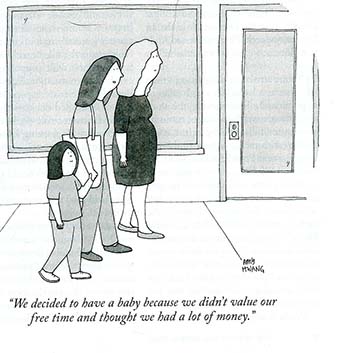Cost of Child Rearing

According to CNN, the cost to raise a child born in 2022 is $310,000 over 18 years.
This doesn't include college.
The high cost of childrearing has led to a sharp drop in family size. Fertility rates are now at or below replacement in many wealthy countries.
Replacement value is about 2.1, but check this chart:
South Korea |
0.72 |
| Singapore |
0.97 |
Japan |
1.3 |
Italy |
1.2 |
Germany |
1.5 |
Spain |
1.2 |
Switzerland |
1.5 |
Canada |
1.4 |
Sweden |
1.7 |
Australia |
1.6 |
UK |
1.6 |
US |
1.6 |
Mali |
6.0 |
Afghanistan |
4.8 |
Niger |
6.75 |
2020 World Bank estimates
Next: Big families
Of course, how much a family actually spends on raising a child depends on how much money the family has. The poorer a family is the less total dollars they spend, but the higher the percentage of their income. So, for example, according to the USDA, lower-income families spend about 8.7 percent of their income on housing a child. For middle-income families, it’s 4.5 percent. And for higher-income families — who spend a smaller share of their income on housing overall — it’s 2.9 percent.
Fertility is dropping all over the world. Niger has the highest fertility in the world, but even there, the number dropped from 7.3 to 6.75 between 2015 and 2024. Worldwide, fertility peaked at 5.3 births per woman in 1963 and has been declining almost continuously since then. In 2024, births per woman stood at 2.2 for the world, just a bit above replacement value. Africa currently remains the region with the highest fertiity. However, fertility is falling rapidly there as well.
The UN predicts that world population will peak at about 10.3 in about 2084 (they had previously predicted this wouldn't happen until the early 21st century). However, other projections have peak population lower and earlier. The Institute of Health Metrics and Evaluation at the University of Washington, for example, predicts a population peak of 9.7 billion in 2064 followed by a sharp drop. Some other scenarios envision the peak as early as the 2040s. We can already see population drop happening. Japan's population peaked in 2008 at 128.54 million. In 2025 it is 123 million. This decline is likely to accelerate in the years ahead.
Population growth is problematic. It leads to resource crunches, habitat loss for wildlife, and expanding pollution and global warming. However, population loss is also problematic. It leads to populations increasingly weighted toward older, less economically productive people and declining numbers of young people to help support them.
Countries have tried to increase their birthrates by literally paying people to have kids. Among the countries doing this are South Korea, France, Italy, Russia, and several others. However, thus far this has proven both extremely expensive and ineffective. Part of the problem is that no country is offering more than a fraction of what it actually costs to raise children. At 2025 prices, the additional money that the US government would have to offer is probably in the range of $400,000 per child. However, even this probably would not do the job.
 In non-industrialized rural communities, people certainly had ambitions, but in most cases, children helped them achieve those ambitions. They wanted respect, they wanted the local equivalent of wealth, they wanted official positions in their communities, they wanted the status objects of their communities. Having large families helped them achieve these ambitions. However, in the modern world, people have different ambitions and goals. They want education, they want material goods purchased with cash, they go to shows and concerts, they want to travel. They increasingly live in cities and want spaces large enough to live comfortably. They certainly still want wealth and status, but having kids no longer promotes this or any other of the goals I just listed.
In non-industrialized rural communities, people certainly had ambitions, but in most cases, children helped them achieve those ambitions. They wanted respect, they wanted the local equivalent of wealth, they wanted official positions in their communities, they wanted the status objects of their communities. Having large families helped them achieve these ambitions. However, in the modern world, people have different ambitions and goals. They want education, they want material goods purchased with cash, they go to shows and concerts, they want to travel. They increasingly live in cities and want spaces large enough to live comfortably. They certainly still want wealth and status, but having kids no longer promotes this or any other of the goals I just listed.
Consider that cars are increasingly necessary around the world. Then consider that the average car both in the US and elsewhere is a five seater (add in that in most of the world cars are far smaller than in the US). Consider that a five seater really only seats four comfortably. This may seem a little trivial, but it's important. It's a signifier of something larger. The way that most of us live in, in wealthy countries throughout the world, and increasingly in middle and lower income contrites, is built around small families. Having a kid is limiting and a lot of work. Having two is a bit more inconvenient, but having three and more raises the level of work and inconvenience a lot.
A very conservative estimate is that between 10 and 15 percent of the population will not have children because of infertility. Many others will choose to have a single child. That means for a population to hold steady, a lot of people need to have three or more children. In the majority of countries in the world, that isn't happening.
BTW, please don't consider any of this advice against having kids. Being a parent has unquestionably been one of the most rewarding and important experiences of my life. But, it's a decision everyone has to make for themselves. There is no shame in having zero to whatever number of kids. However, given the conditions of modern life, it's hard to see a future that doesn't involve long term global population decline.

 In non-industrialized rural communities, people certainly had ambitions, but in most cases, children helped them achieve those ambitions. They wanted respect, they wanted the local equivalent of wealth, they wanted official positions in their communities, they wanted the status objects of their communities. Having large families helped them achieve these ambitions. However, in the modern world, people have different ambitions and goals. They want education, they want material goods purchased with cash, they go to shows and concerts, they want to travel. They increasingly live in cities and want spaces large enough to live comfortably. They certainly still want wealth and status, but having kids no longer promotes this or any other of the goals I just listed.
In non-industrialized rural communities, people certainly had ambitions, but in most cases, children helped them achieve those ambitions. They wanted respect, they wanted the local equivalent of wealth, they wanted official positions in their communities, they wanted the status objects of their communities. Having large families helped them achieve these ambitions. However, in the modern world, people have different ambitions and goals. They want education, they want material goods purchased with cash, they go to shows and concerts, they want to travel. They increasingly live in cities and want spaces large enough to live comfortably. They certainly still want wealth and status, but having kids no longer promotes this or any other of the goals I just listed.